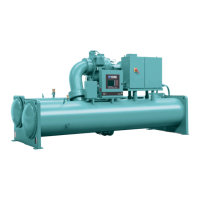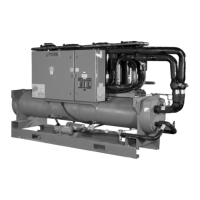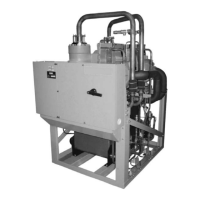except to drain the cooling system. Also the use of a shell and tube heat exchanger is standard on
all models.
The OSCD can now be configured for many different input voltage levels. Lower input voltages may
de-rate the input power rating of the OSCD, but the OSCD will produce the same output voltage
and will use the same motor.
The Harmonic filter is no longer an option, and the function of the Harmonic filter is included in
a new rectifier module. This type of arrangement for the rectifier no longer requires a separate
power unit for the Harmonic filter. Also this rectifier is part of the power unit for the inverter, thus
reducing the number of parts required and increasing reliability.
The new OSCD control system allows for high speed operation of the compressor motor. This
improvement eliminates the need for a gear system between the compressor motor and the
compressor. Without a gear system, reliability and efficiency are improved.
The new power unit consists of a newly designed bus capacitor, new light weight plastic cooling
blocks, new power module gate driver design, new rectifier module, and the cooling system is
connected to the front of the power unit for reduce down time and service cost.
The new Bus capacitor is the core of the power unit. The new capacitor is made of a material that is
much more robust and has a longer lifetime than Bus capacitors commonly used in the past. Also,
this capacitor contains all of the hardware required to mount all of the other parts of the power
unit.
The Harmonic filter operation is now part of the input to the OSCD. This feature is no longer an
option when this OSCD is used with the YMC
2
chiller.
New special plastic cooling blocks were designed for this OSCD. These plastic cooling blocks provide
a light weight solution by replacing heavy copper or aluminum cooling blocks, while providing
direct liquid cooling for the rectifier and inverter power modules. They also provide a method for
mounting the power module assemblies to the bus capacitor within the power unit.
The power unit contains all of the items needed for the output of the OSCD in a highly integrated,
but modular design. On top of the bus capacitor is the laminated bus structure and the gate driver
board on the 0774 and 1278A amp design. The 0490, 0490A, 0612A, and 0730A amp drives also
have the laminated bus structure on top of the bus capacitor or capacitors, but the gate driver
boards are mounted directly above the power modules. A power supply board is located on the
laminated bus structure on the 0490, 0490A, 0612A, and 0730A amp power assemblies. The rectifier
and inverter assemblies are attached to each side of the bus capacitor. The rectifier or inverter
assemblies can be replaced in the field.
Ease of maintenance is provided by using the communications link between the OptiView panel and
the OSCD. The cooling pumps and fans can be turned on from the OptiView panel. This provides for
a safer annual coolant change. The programmed chiller full load amps is now programmed from
the OptiView panel.
Smart Sensor System (SSS) is a system that assists the high ambient temperature fault in the
detection of rapidly rising temperatures.
OptiSpeed compressor drive details (0490 and 0774 amp drives)
An electronic circuit breaker or disconnect switch connects the three phase input power to input
fuses and then onto the AC line inductor, and input filter. See Figure 43. Three phase power
continues onto the rectifier power modules to the bus capacitor to the inverter, then onto the
output filter and the compressor motor.
The AC line inductor provides isolation between the 3 phase power source and the input to the
drive. The AC line inductor improves the input current waveform so that it appears more like a
sine wave. The input filter reduces the effects of the high frequency switching of the rectifier and
provides the inductance for boosting the bus voltage above the peak of the line voltage.
141
YMC
2
Mod B with OptiView
™
Control Center

